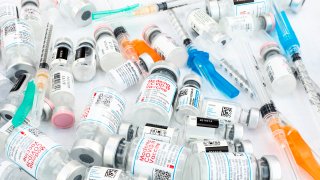
Despite persistent claims to the contrary, none of the three authorized or approved COVID-19 vaccines contains fetal tissue.
In an early phase of development, two of the coronavirus shots — the mRNA vaccines from Pfizer/BioNTech and Moderna — were tested in cell lines that were long ago made from an aborted fetus. And the Johnson & Johnson vaccine is manufactured using a cell line derived from aborted fetal tissue.
Neither fetal cells nor fetal tissue, however, are present in any of the vaccines, and no new abortions were involved in making any aspect of the vaccines possible. Numerous religious groups and anti-abortion organizations have said it is not morally objectionable to receive at least some of the available COVID-19 vaccines.
Confusion about the role of fetal cells or tissue — or lack thereof — with the COVID-19 vaccines has bubbled up most recently due to Supreme Court Justice Clarence Thomas.
We've got the news you need to know to start your day. Sign up for the First & 4Most morning newsletter — delivered to your inbox daily. Sign up here.
In a dissenting opinion issued on June 30, Thomas referred to the religious objections of the petitioners in a case about a New York state mandate for health care workers to be vaccinated against COVID-19.
“Petitioners are 16 healthcare workers who served New York communities throughout the COVID–19 pandemic,” Thomas wrote. “They object on religious grounds to all available COVID–19 vaccines because they were developed using cell lines derived from aborted children.”
Multiple news outlets highlighted Thomas’ comments, with some suggesting that he had made a factual error or was spreading vaccine misinformation. It’s unclear to what degree Thomas was simply summarizing the petitioners’ viewpoint, or whether he agreed with the sentiment.
U.S. & World
The day's top national and international news.
Setting aside the issue of when a developing fetus should be characterized as a child, Thomas’ statement is correct. He is careful to say “developed” instead of manufactured, and does not claim that any of the vaccines contain fetal cells — even if some people mistakenly got that impression from his dissent.
Still, it’s worth providing context to understand what fetal cell lines are, how they’re involved with the COVID-19 vaccines, and how that compares with other vaccines, medical products and scientific research.
Fetal Cell Lines Aren’t Fetal Tissue
As we’ve explained before, the fetal cell lines used in testing, developing or producing some vaccines are distinct from fetal tissue, and no vaccine contains fetal tissue. But some vaccines, including a few of the world’s standard childhood vaccines, have some connection to cells grown in the lab that were originally made using cells taken from an aborted embryo or fetus.
Two of the most commonly used cell strains in vaccine development or manufacturing are MRC-5 and WI-38, which were made decades ago from lung tissue taken from two different aborted fetuses in the U.K. and Sweden in the 1960s. Researchers discovered the cells were useful for the purpose because they were good at growing viruses that infect humans, and many vaccines are made of weakened viruses.
The rubella vaccine, for example, which is part of the measles, mumps, and rubella, or MMR, vaccine, is still manufactured today by growing large quantities of WI-38 cells. The weakened rubella vaccine virus was also developed by passaging the virus in the cells at a temperature below that of the human body. This rendered the virus able to replicate enough to generate long-lasting immunity from the vaccine, but not enough to make a person ill.
Other vaccines produced in fetal cell lines include chickenpox, hepatitis A and one of the rabies vaccines. As the Children’s Hospital of Philadelphia has explained, vaccines manufactured in fetal cell lines do not contain any of the cells because the vaccines are purified.
Fetal Cell Lines and COVID-19 Vaccines
Only one of the U.S.-authorized COVID-19 vaccines is manufactured by growing virus in a fetal cell line.
The lesser-used Johnson & Johnson vaccine, which uses an adenovirus viral vector to initiate an immune response against the coronavirus’s spike protein, is made in a fetal retinal cell line known as PER.C6.
According to the Children’s Hospital of Philadelphia, the cells derive from retinal cells isolated from an aborted fetus in 1985. The cells were then adapted to grow replication-deficient adenoviral vaccines in the late 1990s.
The Pfizer/BioNTech and Moderna vaccines, which do not contain virus and instead are made of messenger RNA, have a more tenuous link to fetal cell lines. Neither vaccine is made in such cells, but both companies did certain experiments testing their vaccines in HEK-293T cells, which are commonly used in biomedical research.
HEK-293Ts are human embryonic kidney cells, derived from cells isolated from a fetus in 1973. It is unclear whether that fetus was miscarried or aborted, according to a handout from the North Dakota Department of Health.
In particular, scientists used HEK-293T cells to make sure the vaccine mRNA could be made into SARS-CoV-2 spike proteins, and also used the cells to create SARS-CoV-2 pseudoviruses to test how well antibodies from vaccinated animals worked to neutralize the virus. Alessondra Speidel, a biomaterials scientist at Sweden’s Karolinska Institute, told National Geographic that such tests were like a proof-of-concept test, showing that the mRNA design worked.
As the North Dakota Department of Health has noted, the Catholic Church and the Southern Baptist Ethics & Religious Liberty Commission have both said it is morally acceptable, given the lack of alternatives, to receive any of the COVID-19 vaccines. However, the U.S. Conference of Catholic Bishops has advised choosing the vaccine with “the least connection to abortion-derived cell lines” if possible. That group has also said that getting a COVID-19 vaccine “ought to be understood as an act of charity toward the other members of our community” and “should be considered an act of love of our neighbor and part of our moral responsibility for the common good.”
Moreover, even the anti-abortion Charlotte Lozier Institute considers the Pfizer/BioNTech and Moderna vaccines to be “ethically uncontroversial.”
Fetal Cell Lines Ubiquitous in Biomedical Research
While the use of fetal cell lines in certain vaccines has long been controversial for some individuals, it’s worth noting that such cells are commonly used in all sorts of basic biomedical research, and that work undergirds much of scientists’ understanding of human biology and disease.
Fetal cell lines are also regularly used to identify new treatments for various diseases and to do research on several common drugs, including acetaminophen, or Tylenol.
Several COVID-19 treatments, such as monoclonal antibodies and the antiviral drug remdesivir, were also tested using fetal cell lines.
“So many people don’t realize how important fetal cell lines are to develop life-saving medicines and vaccines that they rely on every day,” Amesh Adalja, an infectious disease expert at the Johns Hopkins Center for Health Security, told National Geographic. “Their use in developing COVID-19 vaccines isn’t anything different or special.”
By one estimate, as of 2015, more than 10.3 million lives have been saved from the use of vaccines produced by WI-38 cells alone, and 4.5 billion illnesses have been prevented or treated.
New York Vaccination Case
Thomas’ dissent concerned a case brought against New York about a state law that mandated COVID-19 vaccines for health care workers and did not include a religious exemption.
The employees contended that the mandate violated their right to freely exercise their religion, and stated that they could not agree to being immunized with vaccines “that were tested, developed or produced with fetal cell lines derived from procured abortions.”
In a 6-3 decision in December, the Supreme Court rejected two requests from health care workers in New York to intervene after the U.S. Court of Appeals for the 2nd Circuit refused to block the state’s vaccine mandate. Neil M. Gorsuch wrote a dissent, joined by Samuel A. Alito Jr.
Thomas did not join the dissent, but said he would have sided with the health care workers and put a hold on the mandate.
In a brief for one of the cases, the state noted that health care workers in New York were already required to be vaccinated against rubella, for which there was also no religious exemption.
“HEK-293 cells— which are currently grown in a laboratory and are thousands of generations removed from cells collected from a fetus in 1973—were used in testing during the research and development phase of the Pfizer and Moderna vaccines,” the state wrote. “But the use of fetal cell lines for testing is common, including for the rubella vaccination, which New York’s healthcare workers are already required to take.”
On the last day of the term, the Supreme Court declined to review the Court of Appeals’ decision, keeping in place New York’s mandate. It was this decision for which Thomas, a Catholic, wrote his dissent.
Less than a week prior, the court overturned Roe v. Wade, the case that had given Americans a constitutional right to abortion.
Editor’s note: SciCheck’s COVID-19/Vaccination Project is made possible by a grant from the Robert Wood Johnson Foundation. The foundation has no control over FactCheck.org’s editorial decisions, and the views expressed in our articles do not necessarily reflect the views of the foundation. The goal of the project is to increase exposure to accurate information about COVID-19 and vaccines, while decreasing the impact of misinformation.



